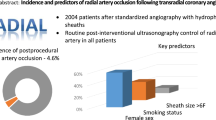Abstract
Background
Transradial access for diagnostic and therapeutic coronary angiography gains more and more popularity because of its advantages over the femoral approach, enhancing patient comfort, reducing bleeding complications and duration of hospital stay. However, these benefits are overshadowed by an increased rate of radial artery (RA) occlusion. There are little data regarding the exact incidence, potential predictors and outcome of post-procedural RA occlusions. Furthermore, there is no clear evidence for the optimal treatment of this complication.
Methods
In a single-centre prospective observational study, 488 consecutive patients were evaluated by ultrasound the day after transradial cardiac catheterization for signs of RA occlusion. Symptomatic patients with sonographically identified radial artery thrombosis underwent treatment with low-molecular-weight heparin (LMWH) for 4 weeks. Asymptomatic patients did not receive anticoagulation therapy. The primary endpoint was the patency rate of the radial artery at 4 weeks of follow-up.
Results
Radial artery thrombosis was found in 51 of 488 (10.5%) patients 1 day after transradial cardiac catheterization. 30 (58.8%) patients showed symptoms on access site, whereas 21 (41.2%) did not show any symptoms. After 4 weeks, 26 (86.7%) of the symptomatic patients showed a partial or complete recanalization of the radial artery after treatment with LMWH, compared with 4 (19.1%) of the asymptomatic patients without anticoagulation (P < 0.001).
Conclusion
Radial artery thrombosis is a frequent complication after transradial coronary angiography. Incidence of RA occlusion is underestimated due to the often asymptomatic clinical course. Treatment of symptomatic RA occlusion with low-molecular-weight heparins significantly increases patency rates after 4 weeks.
Similar content being viewed by others
References
Campeau L (1989) Percutaneous radial artery approach for coronary angiography. Cathet Cardiovasc Diagn 16(1):3–7
Kiemeneij F, Laarman GJ (1993) Percutaneous transradial artery approach for coronary stent implantation. Cathet Cardiovasc Diagn 30(2):173–178
Lindstaedt M et al (2009) Adenosine-induced maximal coronary hyperemia for myocardial fractional flow reserve measurements: comparison of administration by femoral venous versus antecubital venous access. Clin Res Cardiol 98(11):717–723
Agostoni P et al (2004) Radial versus femoral approach for percutaneous coronary diagnostic and interventional procedures; systematic overview and meta-analysis of randomized trials. J Am Coll Cardiol 44(2):349–356
Cruden NL et al (2007) Reduced vascular complications and length of stay with transradial rescue angioplasty for acute myocardial infarction. Catheter Cardiovasc Interv 70(5):670–675
Cooper CJ et al (1999) Effect of transradial access on quality of life and cost of cardiac catheterization: a randomized comparison. Am Heart J 138(3 Pt 1):430–436
Allen E (1929) Thromboangiitis obliterans: methods of diagnosis of chronic occlusive arterial lesions distal to the wrist with illustrative cases. Am J Med Sci 178:237–244
Stella PR et al (1997) Incidence and outcome of radial artery occlusion following transradial artery coronary angioplasty. Cathet Cardiovasc Diagn 40(2):156–158
Slogoff S, Keats AS, Arlund C (1983) On the safety of radial artery cannulation. Anesthesiology 59(1):42–47
Dahm JB et al (2002) A randomized trial of 5 vs. 6 French transradial percutaneous coronary interventions. Catheter Cardiovasc Interv 57(2):172–176
Wu SS et al (2000) 8 French transradial coronary interventions: clinical outcome and late effects on the radial artery and hand function. J Invasive Cardiol 12(12):605–609
Saito S et al (1999) Influence of the ratio between radial artery inner diameter and sheath outer diameter on radial artery flow after transradial coronary intervention. Catheter Cardiovasc Interv 46(2):173–178
Sakai H et al (2001) Limitations of successive transradial approach in the same arm: the Japanese experience. Catheter Cardiovasc Interv 54(2):204–208
Lefrevre T, Thebault B, Spaulding C et al (1995) Radial approach patency after percutaneous left radial artery approach for coronary angiography. The role of heparin. Eur Heart J 16:293
Rathore S, Morris JL (2008) The radial approach: is this the route to take? J Interv Cardiol 21(5):375–379
Hamm CW et al (2008) Diagnostic heart catheterization. Clin Res Cardiol 97(8):475–512
Mann T et al (1998) Stenting in acute coronary syndromes: a comparison of radial versus femoral access sites. J Am Coll Cardiol 32(3):572–576
Bedford RF (1978) Long-term radial artery cannulation: effects on subsequent vessel function. Crit Care Med 6(1):64–67
Choi EY et al (2005) Hemostatic efficacy of hydrophilic wound dressing after transradial catheterization. J Invasive Cardiol 17(9):459–462
Weiner B, Fischer T, Waxman S (2003) Hemostasis in the era of the chronic anticoagulated patient. J Invasive Cardiol 15(11):669–673 quiz 674
Sanmartin M et al (2007) Interruption of blood flow during compression and radial artery occlusion after transradial catheterization. Catheter Cardiovasc Interv 70(2):185–189
Geschwind JF et al (2003) Thrombolytic therapy in the setting of arterial line-induced ischemia. J Endovasc Ther 10(3):590–594
Hildick-Smith DJ et al (1998) Coronary angiography from the radial artery—experience, complications and limitations. Int J Cardiol 64(3):231–239
Ruiz-Salmeron RJ et al (2005) Assessment of the efficacy of phentolamine to prevent radial artery spasm during cardiac catheterization procedures: a randomized study comparing phentolamine vs. verapamil. Catheter Cardiovasc Interv 66(2):192–198
He GW (1998) Verapamil plus nitroglycerin solution maximally preserves endothelial function of the radial artery: comparison with papaverine solution. J Thorac Cardiovasc Surg 115(6):1321–1327
Author information
Authors and Affiliations
Corresponding author
Rights and permissions
About this article
Cite this article
Zankl, A.R., Andrassy, M., Volz, C. et al. Radial artery thrombosis following transradial coronary angiography: incidence and rationale for treatment of symptomatic patients with low-molecular-weight heparins. Clin Res Cardiol 99, 841–847 (2010). https://doi.org/10.1007/s00392-010-0197-8
Received:
Accepted:
Published:
Issue Date:
DOI: https://doi.org/10.1007/s00392-010-0197-8




